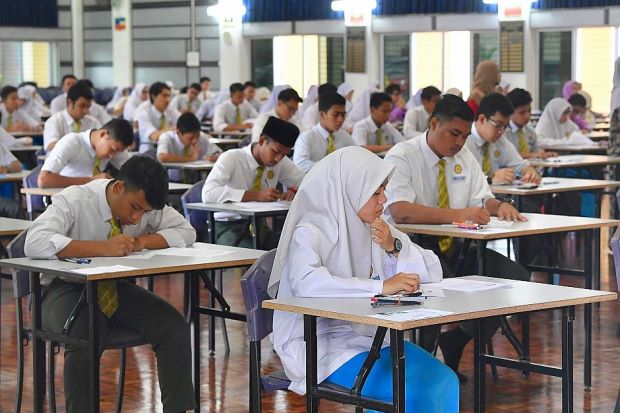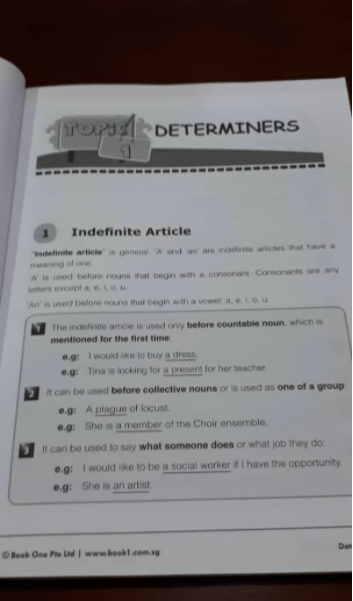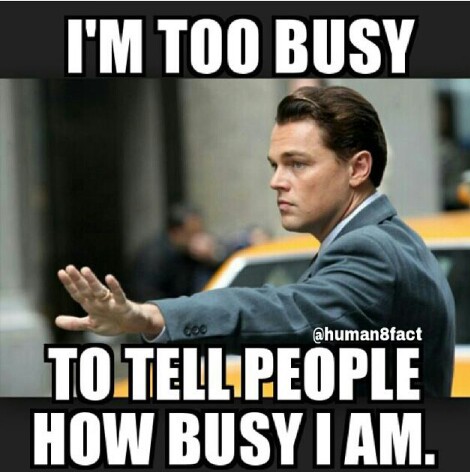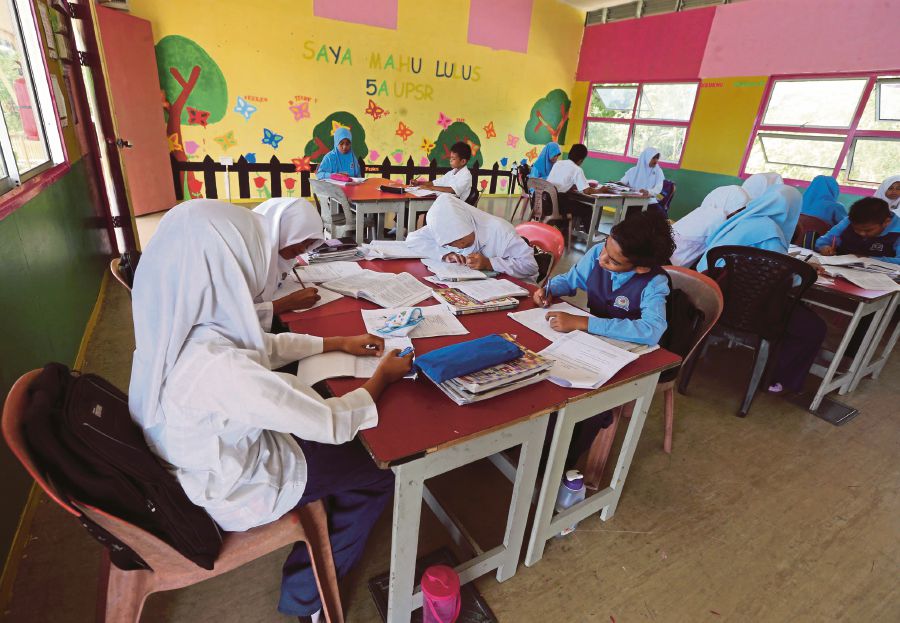Malaysian teachers reveal how much our school system has changed over the years

- 237Shares
- Facebook197
- Twitter5
- LinkedIn8
- Email2
- WhatsApp25
We’ve seen many changes in Malaysia’s education system such as the change of PMR to PT3, the introduction of Higher Order Thinking Skills (HOTS or better known as KBAT) and the recent change on the colour of school shoes! Education Minister, Dr Maszlee Malik, decided to implement black school shoes for every public school starting next year.
He actually came to that decision after receiving complaints from mothers who claimed that white school shoes get dirty too easily. And that’s not all. Parents may also need to spend a lot of money to maintain white shoes with shoe whitening.
However, Dr Maszlee’s intention to implement this was to get parents to send their kids to public schools again.

Remember when we only washed them on Sunday nights and they still didn’t dry on time to avoid scolding the next day? Image taken from Alibaba.com
But these are all the changes most of us are aware of because they’ve been happening over the recent years. But being the curious cats we are, we decided to interview 4 teachers (names aren’t real) who have 20 years or more experience in schools to see what other surprising changes that have happened over the years.
- Ms Chu (has been teaching since 1992)
- Cikgu Annie (has been teaching since 1994)
- En. Sam (has been teaching since 1979)
- Pn Indrani (has been teaching since 1985)
So let’s get on with it. More than 20 years ago, …
1. Teachers could balik at… 2.30pm!
Yeap, that’s true! Ms Chu recalled a time when teaching was a half-day job because after school, teachers could go back by 2:30pm. Back then, they also had more time and were able to focus on teaching their students.
However, teachers nowadays have to stay back till 4:00pm! Ms Chu mentioned that they are given work that they didn’t even sign up for a.k.a clerical work. To add to that, they also have to attend co-curricular activities and meetings. 🙁
Ms. Chu also told us that teachers have so much work these days that they don’t even have the time to concentrate on students.
“I’m a form teacher, library teacher, (if there are) leaking (in school, I) need to call contractor, need to find funds to cover the cost, have to organize events, schools don’t have the budget so we need to raise fund.” – Ms. Chu, told CILISOS in an interview.
Sometimes they need to get used to unfamiliar and non-user-friendly technology for their clerical work. And teachers often need to rush through their lessons when it’s close to exam time. Adding even more to their stress, classroom sizes are already sooo huge. All this work just takes away time for them to prepare their lessons.
The new education minister Dr. Maszlee Malik has recognized that teachers cannot focus on their own job as teachers. He has already spoken about reducing clerical work and decreasing class sizes. So hopefully in the near future, our teachers can do less clerical work.
But teachers aren’t the only ones facing these changes.
2. School became a place for students to compete against each other 🙁

Hands up if you thought that you were already going to fail before the exam even started. Image taken from The Star
Cikgu Annie remembered when she was studying in school, there were a lot of interaction going on because students got the chance to be role models and teach each other different life skills. But based on what she observes now, students have lost their people skills.
Dun, dun, DUNNNNN!!!
Instead of learning from each other, schools are now about competition to see who’s on top.
“Students were more polite in those days. Today the students have lost people skill & life skills. It has become competitive & more like a rat race to see which school can perform better & get the name. It all boils down to who can do better. No time for students to reflect & learn life skills” – Cikgu Annie told Cilisos.
The exam-oriented culture in Malaysia has caused a lot of unnecessary stress for students and the Star reported:
“One in five (students) are suffering depression (18.3%), two in five anxiety (39.7%), and one in 10 suffering from stress (9.6%).” – taken from The Star
Just to clarify things, it’s not exams that are the bad guys here but rather the wrong kind of pressure. Instead of focusing on how much students know, schools are focusing on hitting targets.
Aiyo, is school a place to gain knowledge or what?!

For some reason, this is the vibe our teachers give off when it is results time. GIF taken from GIFER
3. And, nowadays, students don’t even greet teachers anymore! 😮
Back in school, most of us may have greeted our teachers whenever we bump into them… out of norm la. However, we were informed that that practice is gone.
En. Sam told us that students don’t even greet their teachers anymore.
“Last time when you walk to the corridor the students will move for the teacher but now the teacher has to move (he said jokingly). Now there’s no more good morning sir, teacher.” – En. Sam, who is now retired told Cilisos.
His wife, Pn. Indrani also told us that students don’t help teachers to carry books anymore. Teachers had to appoint students to help them!
“(Last time) All will rush to help the teachers but now they just continuing chit chatting. The teachers have to tell them to come to the staff room to help. On their own they don’t want to come. We have to call them.” – Pn. Indrani.
OMG, how did this happen??
Well if you take a look around, the main problem may not be with greeting teachers but the lack in communication among people in general. Young people these days are too engaged with technology (OK, yes we sound like your grandma nagging and ranting at you for always being on your phone but think about it).
Even the smallest things like texting instead of calling shows how much has changed from the past. And because people have all relied so much on texting as a way of communicating, socializing face-to-face is now a challenge.
Not being able to tell social cues is also a problem when it comes to relying on texting too much because when you text, you cannot see the person’s body language or even tell the tone of the person.
“Communication is now slowly decreasing to a point where children and adolescents have trouble even initiating a face to face conversation or holding a conversation, because it is always done through a text message. These children are also developing an inability to read social cues and have empathy” – Written by Danielle Campbell in the Odyssey.
So maybe that’s why when students these days see their teachers, they don’t even know if they should greet or help them out when needed.
4. Students nowadays so lucky hor… teachers kenot rotan them!
Before this, teachers could cane their students when they made mistakes but now they can only be caned with their parent’s permission and the really really severe cases are handed to the guru discipline.
This may be a safety precaution because there are teachers who can be a bit too much lah. One time in Malacca, a kindergarten teacher pushed a student off his chair roughly. Admittedly there have been some cases of teachers abusing students and it may be good to have the parents to oversee the punishment process.
However, that doesn’t have to mean that all forms of disciplinary actions must be removed altogether considering how some actions may bring good discipline.
“Last time canning was allowed. Canning is a good thing. Students will be scared (meaning respect, NOT unnecessary fear).” – En. Sam said in the interview.
“Now we don’t dare to touch the child. We can only use our mouth. Some listen, some don’t bother. Those who don’t bother when the teacher can’t control the children, we need to ask the discipline teacher to come” – Pn. Indrani observed in her school.
Even Ms. Chu told us that teachers could just scold their students at any time previously but, now, even though they can only discipline vocally, they have to be really careful with what they say to jaga-jaga that their disciplinary actions don’t become something huge. One time, a teacher who pinched their student’s ear for discipline got charged.
5. Apparently, there’s a quota to hire teachers… and it’s based on race?!
One interesting fact pointed out by Pn. Indrani was how there were no Chinese and Indians replacing teachers when teachers retire. And it didn’t matter how many Malay, Chinese or Indian teachers were in the school in the past.
There are two possibilities for this. Either teachers are hired based on their race and not ability or for some reason the Chinese and Indians aren’t interested in teaching. But whether or not there really is a racial quota in public schools is unclear.
Cikgu Annie had also noticed this but is unsure if there is actually such thing as this mysterious quota.
“Every time they (Chinese and Indian teachers) apply they don’t get it because of the quota system. Maybe they have for Malays 70%, Chinese only 10%, and Indians 5%. The 80% are Malays even if they aren’t good teachers, not qualified but to fill the quota they accept them anyway” – Pn. Indrani told us based on what she has observed.
Ohhhhh, hashtag…
However, this race-based hiring isn’t just happening in public schools. It already generally happens when people are trying to find jobs. There have been reports about unemployed people trying to get into retail stores, hospitality and public relation positions being rejected just because the applicant wears a tudung.
6. “Aiyo, teacher. My ingrish no good wor.”
Last time, En. Sam used to speak to all his classmates using English regardless of what race they were. There seem to be more polarization now where instead of hanging and speaking with different races in English, everyone just speaks their own mother tongue.
“Last time when I was studying in school, all my Chinese friends never spoke their house dialects” – En. Sam
One of the ways Malaysia’s English proficiency is seen to have dropped is the fact that Pn. Indrani had to teach her secondary school students basic grammar again. Apparently, in primary schools, the way they teach grammar is now based on context.
This means that the students are given paragraphs to fill in the blanks without even learning about basic grammar principles like indefinite articles and maybe even nouns or pronouns. This begs the question, can students figure out the answers without even learning the basics?
“Those days we learn grammar things like verbs nouns all individually, textbooks that individually train all these. Now they only start with a passage, the grammar s there and the child doesn’t know why certain words are there exactly.” – Pn. Indrani

This was what Pn. Indrani had to teach secondary school students. Snapshot of Pn. Indrani’s teaching materials
But here’s something that’s changed for the better in public schools…
7. You can sit in an island (no, literally)
Traditionally, students would always sit and listen to teachers lecturing for hours because if you say one thing, you are considered as disturbing the whole class. So that means, no talking in the classroom, except maybe when the teacher isn’t looking lah, hehe.
But now, there has been a shift in the teaching and learning style because, in recent years, there’s been a move to a more student centered learning approach (like… literally). This has affected the way classroom tables are arranged. In Pn. Indrani’s experience, instead of having tables all facing the teachers, they are now arranged to face one another for group works like these images below:

Remember when the only chance to talk in classrooms were during NIE groupworks? Image taken from The Star
The problem is that the traditional facing teachers arrangement might actually be helping the teachers instead of the students because they are the ones asking the questions or improving the answers instead of students. Compared to a student-centered learning, students get to learn how to think for themselves and they are in control of what they are learning instead of just relying on what the teacher says.
Having said that…
What’s next for public school?
Many things have changed in Malaysian public schools for many, MANY years and our new education minister has a goal of ‘making government schools great again the best choice for its people‘.
Dr. Maszlee is currently bringing the education blueprints for reviews such as the Malaysia Education Blueprint 2013-2025 and the Malaysia Education Blueprint 2015-2025 (Higher Education). He has also started a whole new committee to look at the Malaysian Education Development Plan.
And all of the committee members have proper experience in the educational field. There is the president of the Malaysian Society for Educational Administration (MSEAM), director of the Center for Excellence in Teaching and Cheryl Ann Fernando whom we’ve written about in one of our articles before. Hopefully with their help, they can make Malaysian public school education improve for the future students.
- 237Shares
- Facebook197
- Twitter5
- LinkedIn8
- Email2
- WhatsApp25

















